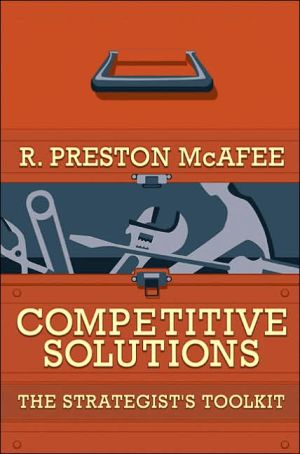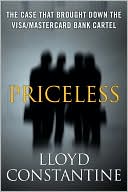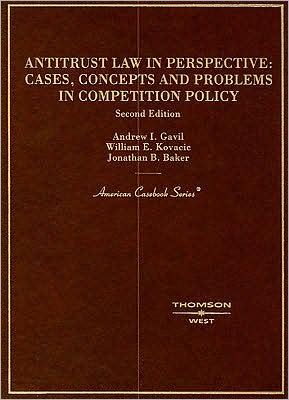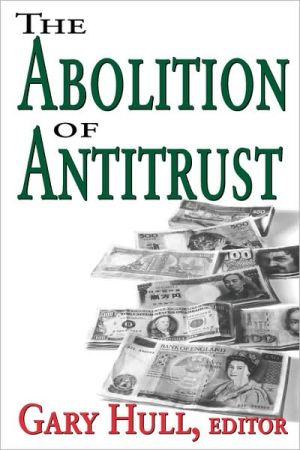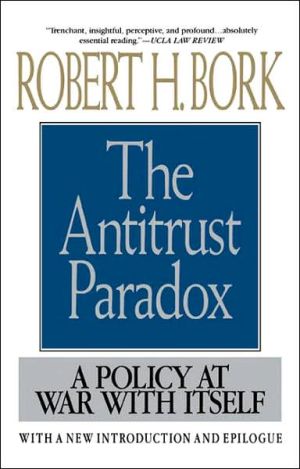Competitive Solutions: The Strategist's Toolkit
Competitive Solutions is an entertaining and wide-ranging introduction to successful business methods applied to a variety of real-world situations. Rejecting the one-size-fits-all premise that underlies so many guides to business strategy, Preston McAfee develops the intellectual tools and insights needed to confront many marketplace problems. Drawing on his broad experience as a consultant for major U.S. companies, as well as extensive research, McAfee emphasizes cooperation, pricing...
Search in google:
"A fascinating read-combining economics and strategy. Just what we need at Samsung."--John Shin, Senior Consultant in Strategy and Leadership, Samsung Electronics, Ltd."Preston McAfee has produced a superb, remarkably comprehensive book on competitive strategy. It is accessible, accurate, and entertaining! Students will stay awake reading it. At its core are numerous examples from actual business settings that are clearly relevant to today's strategist."--Peter Cramton, University of Maryland"This is a very good book that goes a long way toward filling the need for a work on the economics of competition. It has the potential to substantially improve courses in competitive strategy. The coverage is wonderful, the examples are interesting, the informal arguments are excellent, and the style is engaging."--Mark Satterthwaite, Kellogg School of Management, Northwestern University"The very readable style, accessibility, and richness and recentness of examples differentiate this book from some of its competitors in a way that should make it popular with students. McAfee clearly knows his subject well, understands the connections between the theoretical and empirical scholarship in the economics of strategy and the practical challenges faced by strategists, and draws on the latest academic literature and a variety of relevant examples in making his points."--Eric Zitzewitz, Stanford Business School Benjamin E. Hermalin - Journal of Economic Literature [T]his book does an excellent job of translating the insights of modern IO into language that business students can readily grasp. . . . I am confident that this is a book that will be received by good students and will serve well as the main text in any strategy course that approaches the topic.
COPYRIGHT NOTICE: Published by Princeton University Press and copyrighted, © , by Princeton University Press. All rights reserved. No part of this book may be reproduced in any form by any electronic or mechanical means (including photocopying, recording, or information storage and retrieval) without permission in writing from the publisher, except for reading and browsing via the World Wide Web. Users are not permitted to mount this file on any network servers.\ Chapter 1\ INTRODUCTION\ America Online is arguably the most successful Internet-based company, and its success provides a number of lessons in business strategy. Perhaps the most important lesson exemplified by AOL is know your customer. CEO Steve Case spent many hours visiting AOL's chat rooms regularly.1 Chat rooms were designed to provide a more friendly, personalized feel to counteract the geek-oriented, technobabble strategy of rival CompuServe. CompuServe thought AOL had little to offer. According to CompuServe's Herb Kahn: "To us, AOL was junk food and CompuServe was nutritional." But there are worse things than being the McDonald's of on-line services. To further personalize the service, AOL employed a welcoming voice—the infamous "You've Got Mail." AOL was also specifically designed for people who were not computer experts, again in contrast to CompuServe, which generally required a high level of programming expertise.\ Case was not the only AOL executive with a know-your-customer mentality. Robert Pittman, hired to create and solidify the AOL brand, also had the samemind-set. When placed as head of Time Warner's troubled Six Flags amusement park, Pittman decided to dress as a janitor and get a janitor's-eye view of the park. "I learned more in that day about what was going on than I perhaps learned in my whole time there," Pittman said. "Our people who cleaned the park . . . hated our customers because they thought the job was to keep the park clean. Who makes the park dirty? Visitors." Pittman redefined the mission—to make customers happy—to make the role of cleanliness apparent.\ AOL was criticized and derided by many computer users. AOL subscribers, known unaffectionately as "newbies," were banned from some bulletin boards and information groups on the Web, because of the difference in style between early Web users and AOL subscribers. AOL subscribers were friendly and relatively unsophisticated about computers, and they considered the occasional practical joke—such as an incorrect answer to a question—entertaining. This special nature of the AOL subscriber was a consequence of AOL's far-sighted vision of an entire nation communicating electronically. AOL faced the challenges that every innovator faces in building a new market:\ \ Educating potential users. Many AOL subscribers knew little about computers, and less about the Internet, so AOL had to be simple and easy to use in order to reach the mass market.\ \ Building infrastructure. Because the existing network backbone was inadequate for AOL's expanding size, AOL was forced to provide long-distance communications, an operation later spun off to WorldCom.\ \ Dealing with government. Government can be either a hindrance or a help to a new line of business, and the actuality is usually determined by lobbying. AOL found early on that it had to deal with a government that took a suspicious view of the burgeoning Internet, threatened regulation of content to suppress pornography, and might even hold Internet service providers liable for the e-mails of members.\ \ \ Such problems are common in all new industries, but the way that a firm approaches them often determines the firm's long-run success. Failing to educate potential customers limits an operation to the early adopters and creates room for a mass-market firm to run away with the business, as CompuServe found. In contrast, expenditures on education often leave a firm vulnerable to a rival that provides no education but has lower prices. Early computer sellers offered a great deal of in-store know-how, starting with the basement clone industry and growing to include CompUSA and Computer City. The very success early firms had in teaching customers how to use computers led to an industry that did not need such an educational infrastructure, and the necessary services provided by the earliest entrants sowed the seeds of their own destruction.\ IBM exploited the need to build a market in business machines by offering a total solution—bundling equipment, service, and on-site education for a guaranteed successful installation. In this way, IBM exploited the need for customer education to create a recognizable, strong brand, positioning itself for future competition.\ AOL has skirted the problem of competing with low-cost rivals by creating a unique service, one that includes a wide variety of content not readily available elsewhere. AOL offers "bells and whistles," such as AOL keywords and AOL-specific instant messaging, that make AOL attractive to its existing subscriber base. Thus, AOL garnered initial consumers by positioning itself for a mass market of consumers who needed a great deal of help, but it kept them by providing unique services not available elsewhere. AOL's success came as a complete surprise to most of Silicon Valley, which expected AOL to become just another Internet service provider, with content provided by the Web. This view involved a dramatic miscalculation, by first ignoring the sense of community that AOL had built among its subscribers, a community that included not only the internal chat rooms but also a great deal of information, education and references, shareware and useful computer programs, news and financial data, and shopping and travel services. Other firms, notably Yahoo! and MSN (Microsoft Network), came to provide such services as the concept of a portal developed, and these services were offered independently of the customer's Internet service provider. Only AOL, however, tied portal services to Internet service. This tying created a unique service that offered customers value they could obtain only by joining AOL, and that created switching costs for any customer leaving AOL. Essentially, AOL positioned itself in its first phase for ease of use, and in its second phase for value tied to Internet service. This strategy embodies an important understanding of market development: continued success requires creating a transition from the introductory phase to the mature phase of the market.\ AOL is an exemplar of the importance of complementary goods and services, a theme that runs throughout modern strategy. The strategy of tying information and chat to Internet service creates and provides complementary goods that enhance the value of Internet service. While it is not much of a trick to figure out what these goods should be and to provide them, the difficulty is in charging for them. The problem of charges can be seen in Internet mapping-service companies, such as Yahoo, Rand McNally, and MapQuest. The maps are almost equally good, and no one wants to pay for them. Any attempt by one company to charge for them sends customers to an alternative provider. AOL skirts such problems by providing many services as part of its Internet package—a bundle that includes access to the Internet, a browser, chat, instant messaging, entertainment, shopping, financial data, games, and many other conveniences. Many, perhaps most, of these services are available elsewhere on the Internet, often without charge, but finding them takes a certain modicum of expertise unnecessary with AOL.\ Providing complementary goods and services is important because they lock in customers and thus insure continuing superior performance. Sony has used this strategy in the creation of its memory stick—an exchangeable flash-memory product that is used in computers, digital cameras, personal digital assistants (PDA), camcorders, and MP3 music players. The advantage of the proprietary memory stick is that it ties all these devices together. The Sony camcorder buyer gets a memory stick with the camcorder to store snapshots. Since the memory stick can be inserted into a Sony PDA, the Sony brand PDA has higher value to the Sony camcorder buyer. The effect of the memory stick is to create complementarities among Sony products, increasing the value of any one product when others of the same brand are purchased.\ AOL exploits complementarities by tying together a plethora of complementary services. If a customer needs any one of them, he or she is lured to AOL. Perhaps the best example of this strategy is the current "AOL anywhere" campaign—AOL content delivered wirelessly to phones or personal digital assistants. Such an offering enhances the value of AOL's proprietary content, and may encourage AOL subscriptions. Moreover, because of the spillover value, AOL can charge less for this wireless service than Yahoo does for its version of the same thing because AOL captures some of the value through Internet service. In this way, complements both increase the overall product value and create switching costs, thereby increasing firm profits beyond those obtainable when such complements are provided by other firms.\ When it was not efficient to produce complements internally, AOL obtained complements by creating joint ventures and cooperative agreements. Indeed, AOL's early history was characterized by such cooperative agreements with Apple and Commodore. Many business schools have popularized the "business as war" mentality, which is often a mistake; war should be a last resort, both in diplomacy and in business. There are many companies in the same business or in other businesses that can benefit from mutual cooperation. Initially, AOL provided Internet services for firms that could have provided these services themselves, although perhaps not as well as AOL. Both companies benefited from such joint ventures. Moreover, as AOL grew as an Internet company, it signed cooperative agreements with a large variety of other content providers, including ABC, Amex, Business Week, Disney, Fidelity, MTV, Nintendo, Reuters, and Vanguard. Each agreement benefited both companies. AOL benefited by the increased quality and uniqueness of its service, while the content provider was paid and reached a fast-growing audience.\ At one time, Prodigy was larger than either AOL or CompuServe. Like AOL, Prodigy was easy to use and focused on its own content, not on the Internet. Moreover, Prodigy was owned by Sears and IBM and had extraordinary financial resources behind it, so that it could afford to run television advertisements to attract customers. Why did Prodigy stumble and fall? The answer is found in the theory of organizations. Prodigy, as one pundit put it, embodied everything Sears knew about computers and everything IBM knew about retailing,2 but it had the difficulty of serving two masters with significant differences in goals and vision. Moreover, both companies were justifiably afraid of tainting their good name with unwholesome chat and postings. Consequently, Prodigy adopted a heavy-handed approach to administration, cutting off controversial areas and stifling discussion. The company was hobbled by its owners and unable to compete successfully in spite of superior financing and technology. Prodigy was doomed by the same forces that make it difficult for the government of China to resist interfering, and ultimately damaging, the efficient operation of Hong Kong.\ At its core, the theory of organizations suggests that when operations are strongly complementary, it is useful to run them inside a single organization in order to coordinate the aspects of the operations efficiently. In bringing two operations inside the same organization, a loss of incentives will arise; large organizations have inherent inefficiencies in diluted incentives, coordination mix-ups, uninspired yes-men, and other problems of hierarchy. Thus, the advantages of coordination need to be strong to overcome the disadvantages of large operations. In Prodigy's case, the complements—to sell Sears products over the Web, to sell IBM machinery and software to run these operations, and to promote IBM computers for customers—are quite weak. Independent companies like Yahoo feature Sears's products, so that the gain to Sears is only a slightly greater focus on Sears's products. IBM equipment sales were barely affected by Prodigy, which was used mainly by individuals, with the ubiquitous IBM clone made by someone other than IBM. As a result, the gains were tiny; the losses—in organizational flexibility and product design—catastrophic.\ Long after it had grown into a major corporation, AOL was still run as if it were a family business, and this was most apparent in its approach to problems. AOL's problems with busy signals started when it began distributing free disks with a month's free service, and for several years demand outstripped AOL's ability to provide service. While some of the shortfall can be attributed to fast growth and lack of capital, much has to be attributed to poor forecasting and, specifically, to poor statistics.\ The most famous connection problem occurred when AOL changed to unlimited usage. AOL initially provided five hours for $9.95 per month, with additional hours costing $2.95 each. Under pressure from cut-rate internet service providers (ISPs), AOL introduced a "heavy user" plan involving twenty hours for $19.95, and the same $2.95 per month each for additional hours thereafter. With defections growing, AOL caved in and offered unlimited usage for $19.95 per month; consequently, it was swamped with demand that it could not satisfy. Pundits called AOL "America Onhold" or "America Offline." CompuServe ran advertisements featuring a busy signal and the words, "Looking for dependable internet service? CompuServe. Get on with it. 1-888-NOTBUSY." In response, AOL's CEO Steve Case quipped, "It's like people saying they should come to our restaurant because it's empty."\ Case's humor aside, AOL's response to the problem—essentially denying there was a problem—exacerbated the difficulty and created poor public relations. It was a major stumble, which AOL survived primarily because it had already begun locking in customers with its service offerings, and no other firm was well positioned to exploit the error. The way that firms respond to adversity is very important to the perception of their brand going forward. Firms are given a choice in such situations, to respond like Johnson and Johnson did in the Tylenol poisonings, expend resources and garner good public relations and actually build brand capital, or point fingers, deny responsibility, drag their feet, and damage the brand. The early reaction to a crisis is often a strong signal of management's attitude, and this signal will be remembered.\ AOL's response to the pressure to offer unlimited usage was flawed. Unlimited usage at a fixed price is, overall, a bad plan for firm and customers alike. The problem with unlimited usage is the cost of service, currently averaging $.33 per hour, but more like $.50 per hour in 1996. With unlimited usage, customers buy more hours than they are willing to pay for, in particular using hours that they value at less than $.50. Many customers stayed logged on to avoid reaching a busy signal when they tried to log on again; such connections are akin to bank runs, where the fear of not being able to connect (or withdraw money) causes a surge in demand. Charging marginal prices (in this case, zero) below marginal costs does not serve customers or the firm well. In large part, AOL's failure to impose a marginal charge led to poor pricing by the entire industry. Moreover, the lack of a marginal charge sent average usage from seven hours per month to nineteen hours per month in the space of a few months, requiring a huge increase in modems and lines. (Average usage is now thirty-two hours per month.) A modest marginal charge would have tempered this growth in usage, while still encouraging efficient use of the facilities.\ While average costs may have been $.50 cents per hour, not all hours were created equally—the costs primarily reflect peak usage during the early evening. Consequently, AOL could have improved on a marginal charge of $.50 per hour by imposing that charge only during peak hours, when additional demand requires increasing the number of modems. Indeed, a plan that involves a fixed charge, an off-peak marginal charge (which might be zero), and a peak time charge that reflects the cost of increasing the number of modems, would better serve both AOL and its customers. Free off-peak hours would have gone a long way to dealing with the public relations problem of ISPs with unlimited usage, while still economizing on the number of modems required to provide the service, and limiting the busy signals experienced by the customers. Indeed, the modern theory of pricing suggests that menus of pricing, involving fixed charges along with peak and off-peak marginal charges, improve on simpler pricing schemes. Moreover, it is often desirable to offer two classes of service—high and low priority. High-priority service would provide no busy signals, ever. Low-priority customers would be knocked off the service when congestion set in, in return for which they would pay a lower price. The combination of peak and off-peak charges, with multiple classes of service, is known as yield management, and it garners billions of dollars annually for hotels and airlines.\ AOL's cavalier reaction to its problems is an example of bad signaling. But AOL did some excellent signaling, especially in its early years. According to Kara Swisher (of AOL.com), you could see from the lobby into Steve Case's office. "It probably made a favorable impression, because it said he was not egotistical," said reporter Walter Mossberg, "but it also said this was no major corporation that was going to blow anyone away." Markets often react strongly to what seem like small things, such as the position of the president's desk. A 2% correction in a company's earning may send its stock tumbling by a third or more. The theory of signaling shows why such a large reaction is reasonable, and how to manage it.\ AOL illustrates some, although by no means all, of the strategic insights discussed in the book. In particular, AOL matched its product to its customers (chapter 3), used strategic product positioning (chapter 4), exploited the product introduction phase to position itself for the growth and maturity phases of the industry (chapter 5), and exploited complementary products to create a unique service with substantial lock-in and customer value (chapter 2). AOL was also a master of the cooperative joint venture, signing some three hundred such contracts (chapter 6). AOL responded poorly to the busy-signal crisis, ignoring the problem of signaling that magnifies the reaction to such a cavalier attitude (chapter 13). Prodigy's organizational form (chapters 7 and 8) led to a well-funded firm, but one that was unable to compete with the more nimble AOL. AOL's consistent inability to forecast demand showed the importance of an understanding of statistics (chapter 10) in formulating strategy, while the unlimited usage plan shows the central importance of pricing as a tool of strategy (chapter 11).\ EXECUTIVE SUMMARY — INTRODUCTION\ \ Know your customers, by meeting your customer.\ \ Design the product not for early adopters but for the mass market to follow.\ \ Product introduction challenges include educating customers and government, building infrastructure, and supplying other complementary goods.\ \ Expenditures on product introduction may be exploited by low-cost rivals, and a transitioning strategy is necessary.\ \ A necessary feature of a transitioning strategy is to create a unique desirable good or service.\ \ Complementary goods and services are a critical component to modern business strategy and provide the best route to sustained profitability.\ \ Joint ventures and cooperation should be a staple of business strategy.\ \ The theory of organizations suggests that when operations are strongly complementary, it is useful to run them inside a single organization, in order to coordinate the aspects of the operations efficiently.\ \ In bringing two operations inside the same organization, some incentive losses will arise—large organizations have inherent inefficiencies in diluted incentives, coordination mix-ups, uninspired yes-men, and other problems of hierarchy.\ \ Thus, the advantages of coordination need to be strong to overcome the disadvantages of large operations.\ \ The way that firms respond to adversity is very important to the perception of their brand going forward.\ \ The modern theory of pricing suggests that menus of pricing, involving fixed charges along with peak and off-peak marginal charges, improve on simpler pricing schemes.\ \ Moreover, it is often desirable to offer two classes of service—high and low priority.\ \ The theory of signaling is concerned with how to interpret public behavior.\ \ \ \
1Introduction12Industry analysis93Firm strategies364Differentiation615Product life cycle916Cooperation1137Organizational scope1488Incentives1879Antitrust20410Elementary statistics22511Pricing26012Auctions30313Signaling32414Bargaining35315Last words379
\ Strategy & BusinessCompetitive Solutions: The Strategist's Toolkit belongs on every strategist's bookshelf. McAfee is an economist with a gift for selecting and communicating the best new thinking by economists about business, translating from often abstruse mathematics to clear English and understandable examples. McAfee explains economists' latest thinking about pricing, auctions, signaling, and incentives—key decisions that have make-or-break potential for a company.\ \ \ \ \ Journal of Economic Literature - Benjamin E. Hermalin\ [T]his book does an excellent job of translating the insights of modern IO into language that business students can readily grasp. . . . I am confident that this is a book that will be received by good students and will serve well as the main text in any strategy course that approaches the topic.\ \ \ Journal of Economic Literature[T]his book does an excellent job of translating the insights of modern IO into language that business students can readily grasp. . . . I am confident that this is a book that will be received by good students and will serve well as the main text in any strategy course that approaches the topic.\ — Benjamin E. Hermalin\ \
